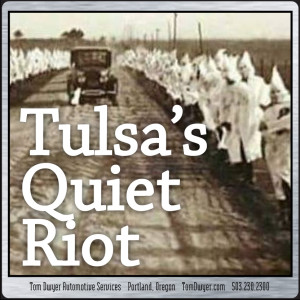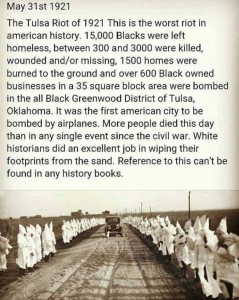
 An internet meme shows a sepia photo of the KKK lining a dirt road. Above it is written “The Tulsa Riot of 1921… This is the worst riot in American history. 15,000 Blacks were left homeless, between 300 and 3000 were killed, wounded, and/or missing, 1500 homes were burned to the ground and over 600 Black-owned businesses in a 35-square block area were bombed in the all-Black Greenwood District of Tulsa, Oklahoma. It was the first American city to be bombed by airplanes. More people died this day than in any single event since the Civil War. White historians did an excellent job in wiping their footprints from the sand. Reference to this can’t be found in any history books.” A haunting post, but when something says there’s a conspiracy of silence around it we get suspicious. We checked into it, and though our suspicions were put to rest we somehow weren’t any happier…
An internet meme shows a sepia photo of the KKK lining a dirt road. Above it is written “The Tulsa Riot of 1921… This is the worst riot in American history. 15,000 Blacks were left homeless, between 300 and 3000 were killed, wounded, and/or missing, 1500 homes were burned to the ground and over 600 Black-owned businesses in a 35-square block area were bombed in the all-Black Greenwood District of Tulsa, Oklahoma. It was the first American city to be bombed by airplanes. More people died this day than in any single event since the Civil War. White historians did an excellent job in wiping their footprints from the sand. Reference to this can’t be found in any history books.” A haunting post, but when something says there’s a conspiracy of silence around it we get suspicious. We checked into it, and though our suspicions were put to rest we somehow weren’t any happier…
The Tulsa Riot is very real, and reading about it reveals a very familiar story. A white woman screamed because of Dick Rowland, a black teenager… no one knows exactly why. Police quickly arrested the teen for sexual assault. A white mob gathered, police turned away offers by veterans to protect Rowland. That night about 75 armed black men met about 1500 armed white men at the courthouse and the riot began. The next day the Greenwood area was invaded and burned. The History.com article gives slightly different numbers than the original post, probably because of the widely varying estimates from all sources. But they also backed up the poster on perhaps the most important point, that there was a conscious effort to expunge Tulsa’s Riot from history.
From History.com- “For decades, there were no public ceremonies, memorials for the dead or any efforts to commemorate the events of May 31-June 1, 1921. Instead, there was a deliberate effort to cover them up.
The Tulsa Tribune removed the front-page story of May 31 that sparked the chaos from its bound volumes, and scholars later discovered that police and state militia archives about the riot were missing as well. As a result, until recently the Tulsa Race Massacre was rarely mentioned in history books, taught in schools or even talked about.”
That eventually, thankfully, changed.
“On the riot’s 75th anniversary Scholars began to delve deeper into the story of the riot in the 1970s, a service was held at the Mount Zion Baptist Church, which rioters had burned to the ground, and a memorial was placed in front of Greenwood Cultural Center.”
After an official state government commission was created to investigate the Tulsa Race Riot, scientists and historians began looking into long-ago stories, including numerous victims buried in unmarked graves. In 2001, the report of the Race Riot Commission concluded that between 100 and 300 people were killed and more than 8,000 people made homeless over those 18 hours in 1921.
A bill in the Oklahoma State Senate requiring that all Oklahoma high schools teach the Tulsa Race Riot failed to pass in 2012, with its opponents claiming schools were already teaching their students about the riot.
According to the State Department of Education, it has required the topic in Oklahoma history classes since 2000 and U.S. history classes since 2004, and the incident has been included in Oklahoma history books since 2009.”
So today, at last, you CAN find Tulsa’s Quiet Riot in the history books, but you may still have to look much too deeply. If you don’t want to dig through the books, we’ve brought a few sources to light for you…
Tulsa Race Massacre, History.com, Aug 2019 (orig Mar 2018)
Greenwood and the Tulsa Race Riots, Video on PBS.org, Feb 2019
1921 Tulsa Race Massacre- The Attack on Greenwood, Tulsa Historical Society and Museum
Meet The Last Surviving Witness To The Tulsa Race Riot Of 1921, Nellie Gilles on All Things Considered, May 2018
A Long-Lost Manuscript Contains a Searing Eyewitness Account of the Tulsa Race Massacre of 1921, Allison Keyes on Smithsonian.com, May 2016
‘We lived like we were Wall Street’- Before the 1921 Tulsa Race Massacre, Greenwood was one of the wealthiest black communities in the country, DeNeen Brown in Washington Post, Oct 2018
These Unforgettable Images Expose The Horror Of The Tulsa Race Riots, Lilly Workneh in Black Voices, Jun 2016
Teachers talk about how black history is being taught in Oklahoma schools today, Nour Habib in TulsaWorld, Feb 2015
75 Years Later, Tulsa Confronts Its Race Riot, Sam Howe Verhovek in the New York Times, May 1996
Riot and Remembrance: The Tulsa Race War and Its Legacy, by James Hirsch










